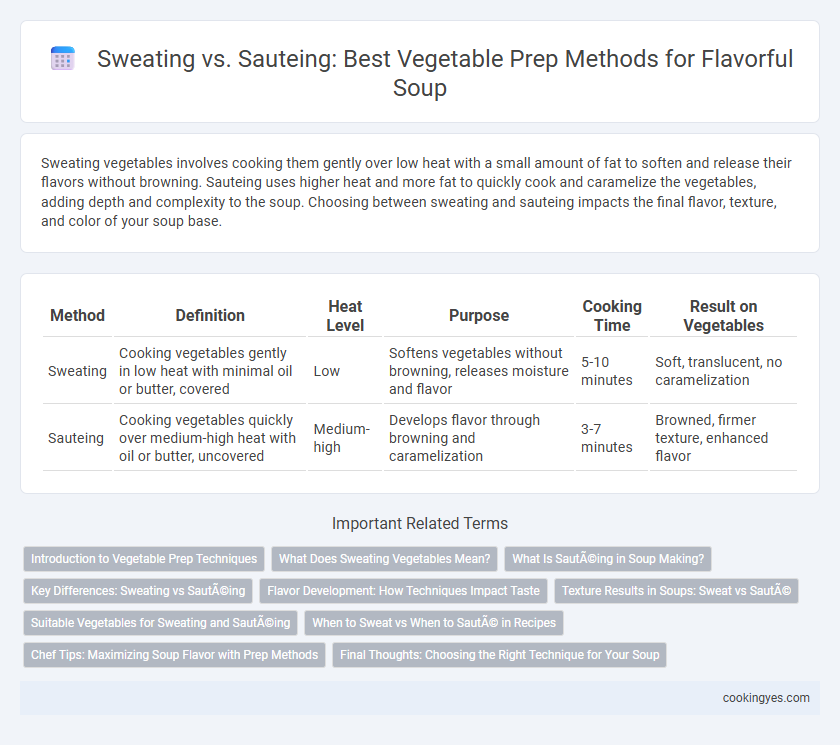Sweating vegetables involves cooking them gently over low heat with a small amount of fat to soften and release their flavors without browning. Sauteing uses higher heat and more fat to quickly cook and caramelize the vegetables, adding depth and complexity to the soup. Choosing between sweating and sauteing impacts the final flavor, texture, and color of your soup base.
Table of Comparison
| Method | Definition | Heat Level | Purpose | Cooking Time | Result on Vegetables |
|---|---|---|---|---|---|
| Sweating | Cooking vegetables gently in low heat with minimal oil or butter, covered | Low | Softens vegetables without browning, releases moisture and flavor | 5-10 minutes | Soft, translucent, no caramelization |
| Sauteing | Cooking vegetables quickly over medium-high heat with oil or butter, uncovered | Medium-high | Develops flavor through browning and caramelization | 3-7 minutes | Browned, firmer texture, enhanced flavor |
Introduction to Vegetable Prep Techniques
Sweating vegetables involves gently cooking them in a covered pan over low heat to release moisture and soften flavors without browning, ideal for soups and stews where a delicate base is desired. Sauteing uses higher heat and oil, promoting caramelization and deeper flavor development through browning, perfect for enhancing the richness of vegetable soups. Both techniques optimize texture and taste, with sweating preserving subtle flavors and sauteing adding complexity through Maillard reactions.
What Does Sweating Vegetables Mean?
Sweating vegetables involves gently cooking them over low heat with a small amount of fat, typically butter or oil, to soften without browning. This technique releases moisture and enhances the natural sweetness and flavors, making it ideal for soup bases and delicate dishes. Unlike sauteing, sweating preserves the vegetable's texture and color while creating a tender, flavorful foundation.
What Is Sautéing in Soup Making?
Sauteing in soup making involves cooking vegetables quickly in a small amount of oil or butter over medium-high heat to develop flavor through caramelization. This technique enhances the soup's depth by creating a richer, more complex base compared to sweating, which uses lower heat to soften vegetables without browning. Proper sauteing releases natural sugars and aromatics, intensifying the taste profile of stocks, broths, and finished soups.
Key Differences: Sweating vs Sautéing
Sweating vegetables involves cooking them slowly over low heat with a small amount of fat to release moisture and enhance natural sweetness without browning. Sauteing uses higher heat and more oil to quickly cook vegetables, creating a browned, caramelized exterior. The key difference lies in temperature and texture: sweating softens vegetables gently, while sauteing produces a crisp, flavorful finish.
Flavor Development: How Techniques Impact Taste
Sweating vegetables gently cooks them over low heat, releasing moisture and enhancing natural sweetness without browning, resulting in a subtle, delicate flavor ideal for clear soups. Sauteing involves cooking vegetables at higher heat with oil or fat, promoting caramelization and Maillard reactions that develop deeper, richer, and more complex flavors perfect for hearty, robust soups. Choosing between sweating and sauteing significantly affects the final taste profile by controlling the intensity and depth of vegetable flavors in the soup.
Texture Results in Soups: Sweat vs Sauté
Sweating vegetables for soup involves cooking them gently over low heat with a small amount of fat, which softens the textures and releases subtle flavors without browning. Sauteing, by contrast, uses higher heat to brown the vegetables, creating a firmer texture and enhancing caramelized, rich flavors that add depth to the soup. Choosing between sweating and sauteing affects the final mouthfeel and complexity, with sweating producing tender bases and sauteing contributing a robust, more textured profile.
Suitable Vegetables for Sweating and Sautéing
Sweating is ideal for delicate vegetables like onions, garlic, leeks, and celery, which release moisture slowly and soften without browning, preserving their subtle flavors in soups. Sauteing suits firmer vegetables such as carrots, bell peppers, zucchini, and mushrooms, where high heat caramelizes their sugars, enhancing their natural sweetness and adding depth to the soup. Understanding these techniques ensures optimal texture and flavor development in various soup recipes.
When to Sweat vs When to Sauté in Recipes
Sweating vegetables involves cooking them gently over low to medium heat with a small amount of oil or butter until they become soft and translucent, ideal for soups and stews where a mellow, sweet flavor is desired without browning. Sauteing requires higher heat and more oil, creating a caramelized exterior that adds depth and complexity, perfect for recipes needing a more robust vegetable flavor or texture contrast. Choose sweating for delicate flavors and moist dishes, and sauteing for bold tastes and a firmer bite.
Chef Tips: Maximizing Soup Flavor with Prep Methods
Sweating vegetables releases their natural sugars and moisture, creating a soft base that intensifies soup flavor without browning. Sauteing involves cooking vegetables at higher heat to develop caramelization and deeper, richer taste through Maillard reactions. Chefs recommend sweating delicate vegetables like onions and garlic to preserve subtle sweetness, while sauteing heartier ingredients such as carrots and celery to add complexity and depth to soup broths.
Final Thoughts: Choosing the Right Technique for Your Soup
Sweating vegetables involves cooking them gently over low heat to release moisture and develop subtle sweetness, ideal for clear, delicate soups. Sauteing uses higher heat and oil to brown vegetables, adding robust flavors and a richer texture suitable for hearty, rustic soups. Selecting between sweating and sauteing depends on the desired soup profile, balancing flavor depth and clarity.
Sweating vs Sautéing for vegetable prep Infographic

 cookingyes.com
cookingyes.com